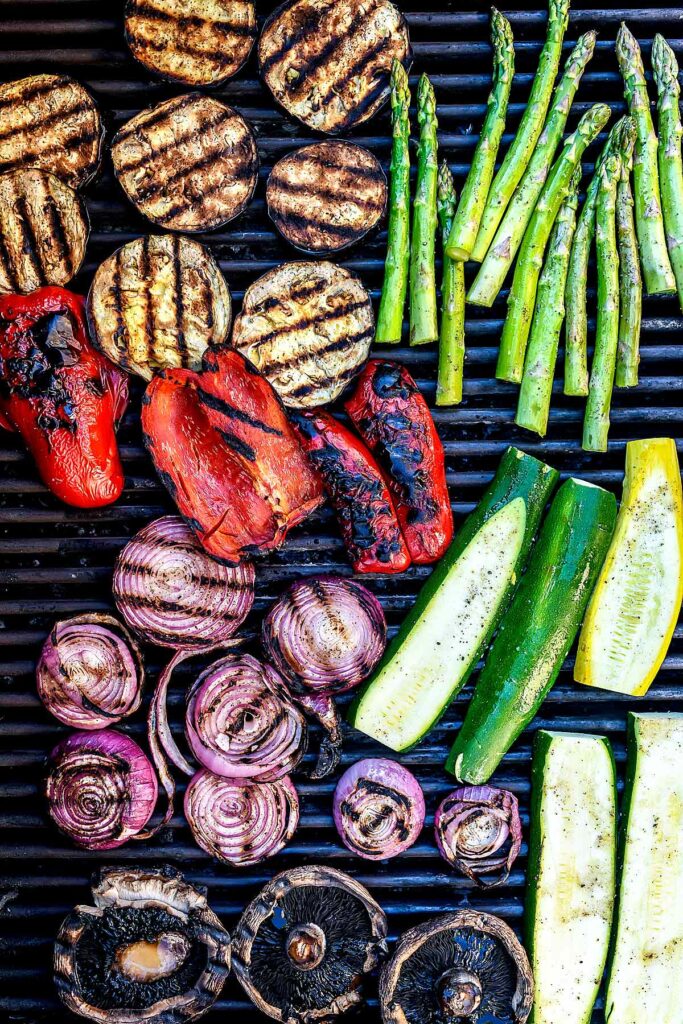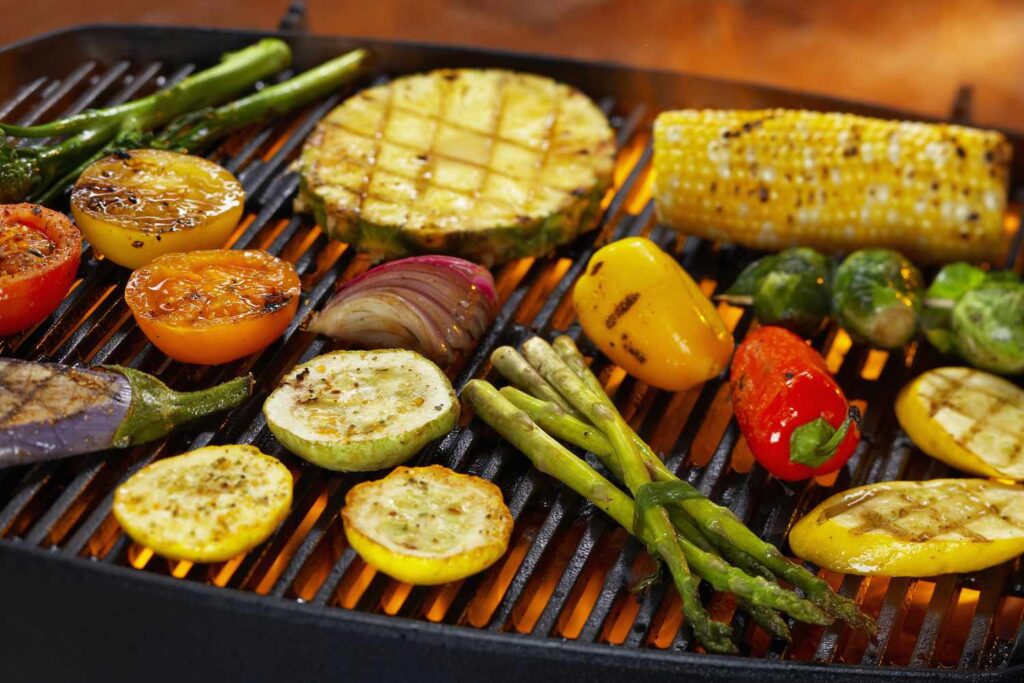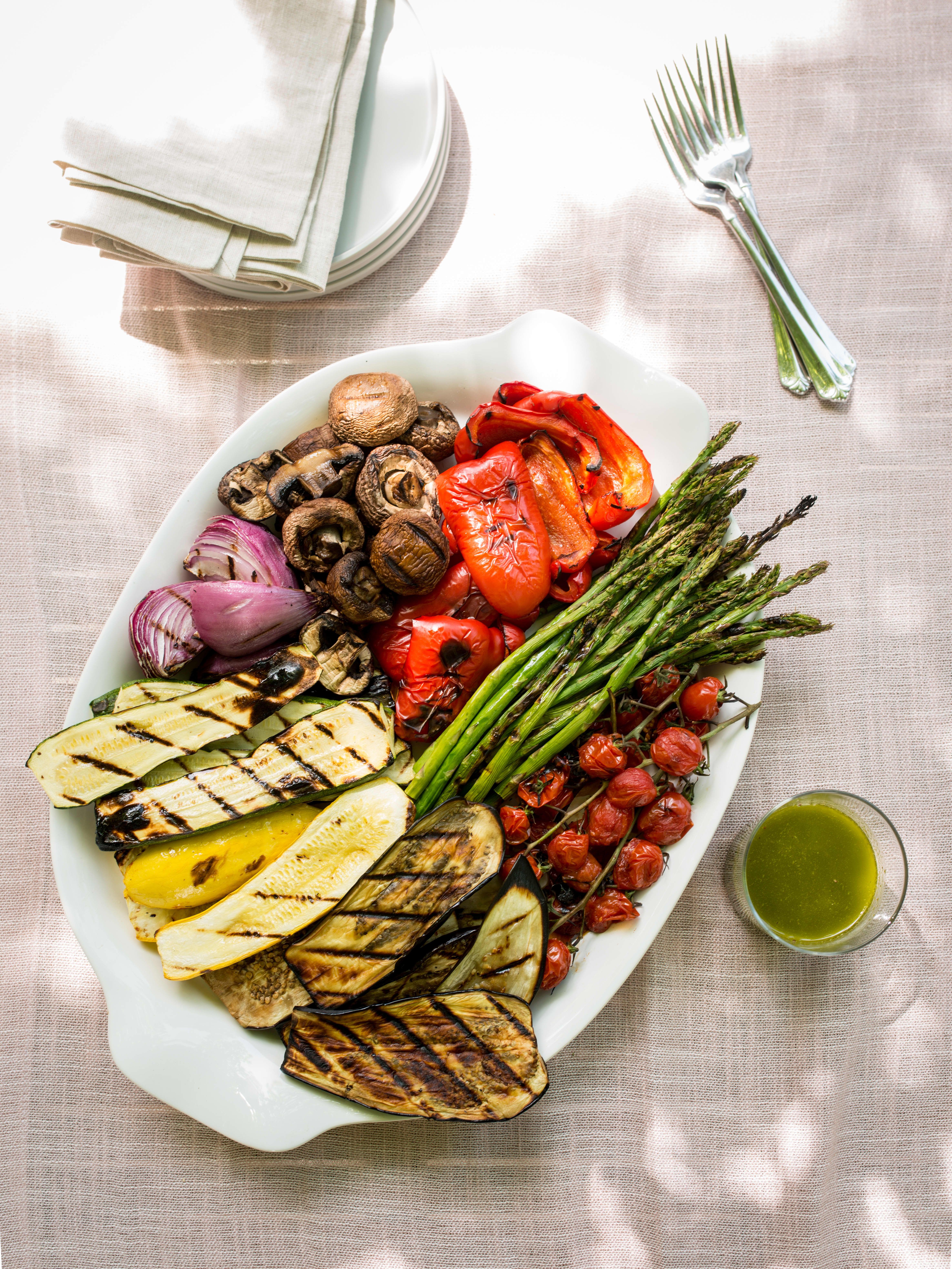Are you craving some delicious and healthy grilled vegetables? Look no further, because we’ve got you covered with our top tips for grilling the perfect vegetables. Whether you’re a grilling pro or just starting out, these tips will ensure that your veggies turn out juicy and flavorful every single time. From selecting the right vegetables to mastering the grill temperatures, you’ll be able to impress your friends and family with your veggie grilling skills. So grab your tongs and get ready to create mouthwatering grilled vegetable dishes that will leave everyone asking for seconds.

This image is property of www.foodiecrush.com.
Choosing the right vegetables
Fresh and ripe vegetables
When it comes to grilling vegetables, choosing fresh and ripe produce is essential. Look for vegetables that are firm, vibrant in color, and free from blemishes or bruises. Fresh vegetables not only taste better but also grill more evenly, resulting in a delicious final product.
Vegetables with even thickness
To ensure that your vegetables cook evenly on the grill, it’s important to choose ones that have a consistent thickness. This allows for more uniform cooking and prevents some pieces from being undercooked while others are overcooked. If you have irregularly shaped vegetables, consider slicing them into even-sized pieces to promote even cooking.
Vegetables that hold their shape
Some vegetables are better suited for grilling because they hold their shape well during the cooking process. Vegetables like bell peppers, zucchini, eggplant, and onions are great options as they don’t become too soft or mushy on the grill. Choosing vegetables that hold their shape will give you a satisfying texture and maintain their visual appeal.
Preparing the vegetables
Washing and drying the vegetables
Before grilling your vegetables, it’s important to wash them thoroughly to remove any dirt or residue. Use cool running water and gently rub the vegetables to remove any debris. Once they are clean, make sure to dry them completely. Excess moisture on the vegetables can prevent them from achieving a nice char and may cause them to steam instead of grill.
Trimming and cutting the vegetables
Trimming and cutting your vegetables is an essential step in preparing them for the grill. Remove any stems, leaves, or parts that are not edible. It’s also important to cut the vegetables into appropriately sized pieces to ensure even cooking. Larger vegetables like eggplant or zucchini can be sliced into thick rounds or lengthwise strips, while smaller vegetables like cherry tomatoes can be left whole.
Marinating the vegetables
Marinating your vegetables can add an extra layer of flavor and help prevent them from drying out on the grill. Prepare a marinade using your choice of herbs, spices, oil, and acids like vinegar or lemon juice. Coat the vegetables in the marinade and let them sit for at least 30 minutes, or even overnight in the refrigerator for more intense flavor. Marinating also helps to tenderize the vegetables, making them more enjoyable to eat.
Preheating and preparing the grill
Cleaning the grill grates
Before grilling your vegetables, it’s important to clean the grill grates to prevent any sticking or unwanted flavors. Use a grill brush to remove any debris or food particles from the grates. This will also help to ensure even heat distribution and proper cooking of your vegetables.
Preheating the grill
Preheating the grill is a crucial step in achieving perfectly grilled vegetables. Turn on your grill and let it heat up for about 10-15 minutes. This allows the grates to reach the desired temperature and ensures that your vegetables will cook evenly. Preheating also helps to create those beautiful grill marks that add visual appeal to your dishes.
Oil the grill grates
To prevent your vegetables from sticking to the grill grates, it’s important to oil them before cooking. Use a pair of tongs and a folded paper towel soaked in vegetable oil to lightly grease the grates. This will create a non-stick surface and help your vegetables to release easily, without tearing or breaking apart.
Direct vs. indirect grilling
Direct grilling
Direct grilling involves placing the vegetables directly over the heat source. This method is ideal for smaller and thinner vegetables that cook quickly, such as asparagus spears or green beans. The high heat creates a nice char and adds a delicious smoky flavor to the vegetables.
Indirect grilling
Indirect grilling involves cooking the vegetables away from the direct heat source. This method is more suitable for larger or thicker vegetables like potatoes or corn on the cob. By cooking the vegetables indirectly, you reduce the risk of burning or charring them, allowing for a more even and gentle cooking process.
Choosing the right method for different vegetables
It’s important to choose the grilling method that best suits the vegetables you are cooking. For a variety of vegetables in a single grilling session, you can use a combination of direct and indirect grilling. This will ensure that each vegetable cooks at the appropriate temperature and for the right amount of time, resulting in perfectly grilled vegetables across the board.

This image is property of www.foodiecrush.com.
Seasoning and flavoring the vegetables
Choosing the right seasonings
Seasonings play a crucial role in enhancing the flavor of grilled vegetables. Consider using a blend of herbs and spices like garlic powder, paprika, cumin, or oregano. The choice of seasoning will depend on personal preference and the overall flavor profile you want to achieve. Experiment with different combinations to find the perfect seasoning for your grilled vegetables.
Using marinades and sauces
Marinades and sauces are a great way to add flavor and moisture to your grilled vegetables. You can choose to marinate the vegetables before grilling or baste them with a sauce during the cooking process. Common marinades for grilled vegetables include a combination of olive oil, balsamic vinegar, soy sauce, or citrus juice. Barbecue sauce, teriyaki sauce, or chimichurri are excellent options for basting.
Adding herbs and spices
Herbs and spices can take your grilled vegetables to the next level. Consider adding fresh herbs like basil, parsley, thyme, or rosemary to your grilled vegetables for a burst of freshness. Sprinkle spices like chili flakes, black pepper, or smoked paprika for an added kick. Fresh herbs and spices not only add flavor but also give your grilled vegetables a beautiful visual appeal.
Grilling techniques for different vegetables
Grilling root vegetables
Root vegetables like potatoes, carrots, or beets require a longer cooking time due to their dense nature. Begin by partially cooking them before placing them on the grill. This can be done by boiling or roasting the vegetables until they are slightly tender. Once partially cooked, brush them with oil or marinade and grill until they are fully cooked and have a delicious smoky flavor.
Grilling leafy vegetables
Leafy vegetables like romaine lettuce or kale can be grilled to add a unique twist to your salads or side dishes. Start by brushing the leaves lightly with oil and grill them over medium heat for a short amount of time, just until they begin to wilt and develop grill marks. Grilled leafy vegetables offer a smoky flavor and a delightful textural contrast to your dishes.
Grilling delicate vegetables
Delicate vegetables like cherry tomatoes, mushrooms, or asparagus need to be handled with care on the grill. To prevent them from falling through the grates or sticking, you can use skewers or grill baskets. Skewer smaller vegetables or place them in a grill basket to ensure they are evenly cooked and easily removed from the grill. Delicate vegetables cook quickly, so keep a close eye on them to avoid overcooking.

This image is property of www.thespruceeats.com.
Using skewers or grill baskets
Using skewers for smaller vegetables
Skewers are a great tool for grilling smaller vegetables that can easily fall through the grates. You can use metal or soaked wooden skewers to thread vegetables like cherry tomatoes, mushrooms, or chunks of bell peppers. Remember to leave enough space between the vegetables to ensure even cooking. Skewers also make it easier to flip the vegetables and create grill marks on all sides.
Using grill baskets for small or delicate vegetables
Grill baskets are another convenient option for grilling small or delicate vegetables. These wire baskets with handles allow you to place the vegetables inside and cook them directly on the grill. Grill baskets prevent the vegetables from sticking or falling through the grates while still allowing the heat and smoke to infuse them with flavor. Ensure the basket is well-oiled before adding the vegetables to prevent sticking.
Choosing the right tools
When using skewers or grill baskets, it’s important to choose the right tools for the job. If using wooden skewers, make sure to soak them in water for at least 30 minutes before skewering the vegetables to prevent them from burning on the grill. Metal skewers are a durable option that can be reused and are easier to handle. Opt for a grill basket that is sturdy and has a fine mesh, allowing for better heat distribution and cooking.
Grilling times and temperatures
Determining the grilling times
Grilling times can vary depending on the type and thickness of vegetables you are cooking. Thicker vegetables like potatoes or corn on the cob will require longer cooking times, while thinner vegetables like asparagus or green beans will cook quickly. Experiment and keep track of the cooking times for different vegetables to find the perfect balance.
Adjusting temperatures for different vegetables
Adjusting the grill temperature is key to achieving perfectly grilled vegetables. For dense or thicker vegetables, start with medium-high heat and then reduce it to medium or low to ensure thorough cooking without burning the exterior. Delicate or thinner vegetables can be grilled over medium to medium-high heat for a shorter time to prevent them from becoming overly soft.
Avoiding overcooking or undercooking
To avoid overcooking or undercooking your vegetables, it’s important to keep a close eye on them during the grilling process. Turn the vegetables occasionally to ensure even cooking on all sides. Use a fork or tongs to test for doneness by piercing the vegetables. They should be tender but still have a slight bite. Remember that vegetables will continue cooking after being removed from the grill, so remove them when they are slightly undercooked to achieve the perfect texture.
This image is property of cdn.apartmenttherapy.info.
Grilling tips for perfect texture and appearance
Achieving grill marks
Grill marks not only add visual appeal to your vegetables but also enhance their flavor. To achieve those coveted grill marks, make sure your grill grates are clean and well-oiled before cooking. Sear the vegetables over direct heat for a few minutes without moving them to allow the marks to develop. Then, rotate the vegetables 90 degrees and continue cooking to create a crosshatch pattern.
Retaining crunchiness or tenderness
Grilling vegetables is an art, and achieving the perfect texture is essential. For vegetables that you want to retain crunchiness, like zucchini or bell peppers, grill them over medium-high heat for a short amount of time. This will cook them through while still maintaining their crispness. For vegetables that you want to be tender, like onions or eggplant, grill them over medium heat for a longer duration until they become soft and develop a caramelized flavor.
Ensuring even cooking
To ensure even cooking of your vegetables, it’s important to cut them into similar sizes. This allows for uniform contact with the grill grates and prevents some pieces from being overcooked or undercooked. Additionally, arranging vegetables that require similar cooking times together on the grill can help achieve even cooking. Monitor the grill temperature and adjust it as needed to ensure all your vegetables cook evenly and to perfection.
Serving and garnishing the grilled vegetables
Serving suggestions
Grilled vegetables can be served in a variety of ways to showcase their smoky flavor and vibrant colors. You can serve them as a side dish alongside grilled meats, toss them into salads for added texture and flavor, or even use them as a filling for sandwiches or wraps. Grilled vegetables can also be enjoyed on their own as a healthy and delicious vegetarian option.
Garnishing with herbs or sauces
Garnishing your grilled vegetables can elevate their taste and presentation. Fresh herbs like basil, cilantro, or mint can be chopped and sprinkled over the vegetables to add brightness and freshness. Drizzling a flavorful sauce like chimichurri, tahini, or a balsamic reduction can enhance the overall flavor profile. Get creative and experiment with different garnishes to find what complements your grilled vegetables best.
Pairing with other dishes
Grilled vegetables can be a versatile addition to various dishes and can be paired with a wide range of flavors. They complement grilled meats or seafood beautifully, adding a burst of color and freshness to the plate. They can also be used in pasta dishes, rice bowls, or grain salads, providing a nutritious and flavorful component. Consider the overall meal when deciding on the seasonings and flavors for the grilled vegetables to ensure a harmonious combination.
By following these top tips for grilling the perfect vegetables, you’ll be able to enjoy a variety of delicious and flavorful dishes that highlight the natural goodness of your favorite veggies. Whether you’re grilling for a casual backyard barbecue or creating a gourmet meal, these tips will help you achieve the desired texture, appearance, and taste in every bite. So fire up that grill, gather your freshest vegetables, and get ready to impress your friends and family with your grilling expertise!

This image is property of www.fix.com.

